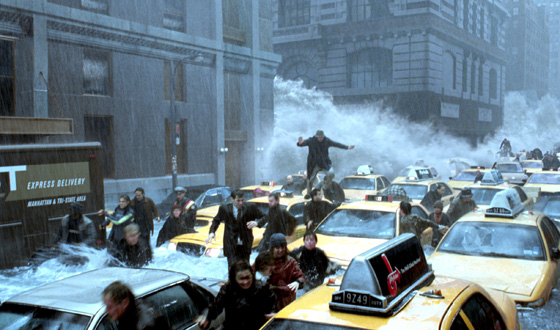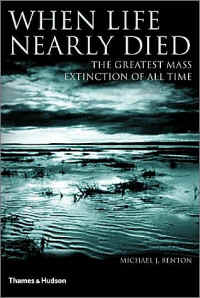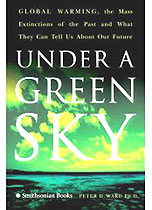
| Palaeos: Paleozoic |  |
Permian Period |
| Paleozoic Era | Permian: Extinction Events |
| Page Back | Back: Carboniferous | Back: Neoproterozoic | Up: Permian | Unit Home |
| Page Next | Next: Triassic | Next: Mesozoic | Down: Cisuralian | Timescale |
Originally there was thought to be only a single end Permian mass extinction. More accurate stratigraphic resolution reveal two huge mass extinction events, one at the end of the Guadalupian epoch and the other at the end of the Permian (and because taxonomic losses were divided between the two crises and the intervening interval, the terminal extinction eliminated only about 80 percent of marine species, not 95 or 96 percent as previously estimated) (Stanley & Yang 1994, although this thesis is not without its critics, e.g. Clapham et al 2009). Gregory Retallack (a specialist in fossil soils) and co-workers have associated these mass extinctions with catastrophic greenhouse events and herperanoxia. Retallack 2005 Retallack et al 2006. They use new paleobotanical, paleopedological, and carbon isotopic studies of Portal Mountain, Antarctica, and comparable studies in the Karoo Basin, South Africa to shown that there were two separate abrupt mass extinctions on land, which can also be linked to corresponding marine invertebrate extinctions. One was the end Guadalupian (end Capitanian), the other the better known end Permian extinction. Both were times of short-lived warm and wet greenhouse climate, marked soil erosion, transition from high- to low-sinuosity and braided streams, and wetland soil stagnation. Retallack et al 2006 (abstract)
This research with carbon isotopes also hints at a further, earler mass-extinction at the end of the Cisuralian. If so, these extinction events would explain the three radically different dynasties of terrestial life duriong the Permian - the pelycosaur, dinocephalian, and advanced therapsid. Retallack et al 2006 give the following diagram, which is reproduced here


In order to explain how the necessary amounts (a hundred to a thousand gigatons) of methane could be released into the atmosphere within a period of 10 to 100 thousand years, Retallack et al 2006 p.1409 suggest catastrophic methane outbursts to the atmosphere from from Volcanic intrusion (feeder dikes and flood basalts) into massive coal deposits. They mention that both the end-Guadalupian Emeishan Basalt (Zhou et al., 2002) and end-Permian Siberian Traps (Kamo et al., 2003) (see illustration above) erupted through pre-existing coal measures.
Another (perhaps complementary) cause, suggested by Isozakia 2009 was mantle superplume activity, which also led to the Illawarra Magnetic Reversal
For much of the Triassic, oxygen levels remained low, and according to Ward 2006, this favoured dinosaurs which - like birds would have had a more efficient aerobic metabolism, over mammals. Early Triassic survivors of the mass extinction like Lystrosaurus and Proterosuchus had stocky bodies and barrel-chests indicating increasing lung capacity, while therapsid carnivores like Galesaurus and Thrinaxodon had reduced lumbar ribs which, along with thickened thoracic ribs and higher thoracic vertebral spines may well indicate enlarged lungs and a muscular, mammal-like diaphragm, allowing more efficient respiration. Retallack et al 2003 p.1148

Disaster movies are a staple of Hollywood today, and it might be plausibly suggested that the depth and complexity of their stories and their degree of realism varies in inverse proportion to the size of their special effects budget. The genre being as popular as it is, few subjects in earth history excite the imagination of the average person as much as the terminal Permian extinction (which corresponds to the third of the carbon isotope anomalies shown in the previous diagram). This is a shame, because the Permian is an amazing chapter in the history of life, and it is rather limiting to focus so much on its final pages.
But the allure of disaster movies being what it is, real-life equivalents of the subject continues to fascinate. To get a better perspective on the end-Permian disaster blockbuster, it may be useful look at two (or more) very different accounts, in two very different books, each by a paleontologist, and each on thr same subject (well, more or less...) (The Benton review has been filched from the Book Reviews section)
 Benton,
Michael J. (2003), When Life Nearly Died: the Greatest Mass Extinction of all Time. Thames & Hudson, 336 pp. ISBN 0-500-05116-X
Benton,
Michael J. (2003), When Life Nearly Died: the Greatest Mass Extinction of all Time. Thames & Hudson, 336 pp. ISBN 0-500-05116-X
Michael Benton's latest book is a semi-popular explanation of the end-Permian extinction. Over the last two decades, paleontologists have reached consensus that the end-Permian ("PT") event was the greatest biotic disaster of the Phanerozoic, and possibly of all time. It is hard to know how seriously to take figures of this sort, but Benton cites species extinction rates of 95% and more. Even this figure, he suggests, is conservative because it does not take into account additional pulses of extinction, including a slightly later Olenekian event. He describes the PT devastation as world-wide, non-selective, and so thorough that ten million years were required to recover to more or less normal levels of biodiversity.
Explaining why and how the PT extinction happened is a difficult task, but Benton does it very well indeed. More than half of the book is history and background. Normally, this would be irritating, but Benton covers it so fluidly that one doesn't really mind. The heart of the PT problem is stratigraphy -- both the science of stratigraphy and the philosophical bias of the stratigraphic community. Benton has an almost unmatched ability to tell the science part of any paleontological tale in plain, straightforward prose. In this book, Benton shows us that he can also produce, at the same time, a well-structured story about the interaction between philosophy and science in the geological community, as well as the interplay between geologists, paleontologists, and others. In short, this is that rare book, a really balanced and compelling study of a scientific idea, including both its content and its history.
Personally, I am perhaps even more impressed with Benton the historian than with Benton the writer or Benton the paleontologist. He never bogs down in personalities. He tries to understand both Victorian Englishmen and Soviet apparatchiks on their own terms and usually succeeds. True, he inserts the conventional reminder that the former were arrogant imperialists, and he does gloss over some uncomfortable truths about Soviet science -- all according to the latest academic fashion. However, Benton's writing is too clear and honest to allow even self-deceptions to cloud the facts.
If there is any disappointment in the book, it is on the science side. However, this was intended to be a semi-popular book, and it would be churlish to expect too much. Benton concludes that the Siberian Traps were responsible for the PT extinction. If his marshalling of the evidence for this hypothesis is less than compelling, it is probably only because the evidence itself is still less than compelling.
He is probably correct, but there are aspects of the PT event which are still very unclear. Unfortunately, most of these issues remain unresolved due to the same problems which have bedeviled the PT question from the very beginning -- the intractable issues of dating and stratigraphy around the PT boundary. We just don't know, not even to an order of magnitude, how long the die-off took. Our knowledge of the recovery phase is just as bad. Everyone agrees that the recovery took a long time. Certainly it took over a million years, but whether it was 1, 5, 10, or 20 My depends on what one's criteria are and on the uncertainties of Early Triassic stratigraphy.
A few examples will suffice. The Induan Age, the first age of Triassic, has been shrinking. Not very long ago, it was supposed to have lasted about 5 My. Now, the best estimate is 1.3 My and possibly as little as 0.2 My. Obviously this makes a huge difference in how one views the initial post-PT world. Another problem is the supposed Late Olenekian extinction. Benton views it as a mass extinction. Others see it (as Benton is fair enough to state) as faunal turnover connected with recovery, much like a succession series in any ecological recovery (see our discussion at Olenekian). Which view is correct depends critically on what organisms were where and at what time. The issue simply cannot be resolved without a much finer parsing of the stratigraphic record.
But enough of that sort of thing. The scientific issues are sometimes frustrating and difficult. The book, on the other hand, is simply a really good book. At the moment, its US$30 price is a bit steep for many of us; but, by all means, get it when you can. ATW040209.
Postscript: very recent dating of the Siberian flood vulcanism places this series of events at about 251.3 Mya, with most locations dating between 251.7 and 251.1 Mya (all dates ±0.3 My), resulting in the extrusion of 2-4 million cubic kilometers of volcanic material. Kamo et al. (2003). This is extremely close to the currently accepted date for the end-Paleozoic of 251.0. Unfortunately, the Permo-Triassic boundary is placed about 1My after the main pulse of extinction. So we still have a small, but annoying gap, with the extinctions taking place slightly before Central Siberia turned into an incandescent mud bath. In addition, the figures sound large, but amount to no more than a single Krakatoa-size (20 km³ ejecta) event every 4 years, on the average. Maybe enough to threaten the existence of life, but maybe not. Once again, we just don't have the temporal resolution down fine enough to tell. If, for example, 100 Krakatoas, had exploded during even one of those 500-600 ky, we might well not be around today to discuss the matter today. The odds are that no more than 10-15 or so would have occurred in even the worst year, if the distribution were random. [Check my math: I make it 3,000,000 km³/ 20 km³ = 150,000 Krakatoa-equivalents. 150,000 Keq / 600,000 yr = 0.25 Keq/yr on the average. The chance of 10 in any given year is then (0.25)10 = 9.54 X 10-7. The chance of ten not happening at all in 600,000 years is (1 - 9.54 X 10-7)600,000 = 0.564] However this assumes that the rate of vulcanism was randomly distributed, which is a very, very bad assumption.
Kamo, SL, GK Czamanske, Y Amelin, VA Fedorenko, DW Davis & VR Trofmov (2003), Rapid eruption of Siberian flood-volcanic rocks and evidence for coincidence with the Permian-Triassic boundary and mass extinction at 251 Ma. Earth & Planet. Sci. Lett. 214: 75-91.
ATW041004. No rights reserved.
Now for something a bit different - a bit more impalusible and eccentric

Paleontologist and Science writer Peter Ward proposes the theory (in his book Under a Green Sky), that the Permian mass-extinction, along with the other four major extinctions, were the result of runaway greenhouse effect, which heated the oceans and shut down the ocean conveyor belt. This is the phenomenon by which warm and hence poorly oxygenated surface water cools when it approaches the poles, taking in oxygen and sinking to the bottom, where it carries the oxygen rich watre to the equator. At the equator it warms and rises, repeating the cycle.
Without this cycle, the oceans become berift of oxygen (this is called the "Strangelove Ocean", after the famous Stanley Kubric Cold War black comedy Dr Strangelove), life suffocates and dies, and anaerobic archaea and bacteria flourish. This is deadly for two reaons. First, some of these microrganisms (the methanogens) produces huge amounts of methane, further adding to the greenhouse effect. Others, the sulfate-reducing organisms, generate vast amounts of hydrogen sulfide, better known as rotten egg gas. Ward describes a nightmare scenario, with poisonous oceans belching methane, turning the sky green and hazy and poisoning plants and animals.
Personally, I find it hard to believe that any higher life and developed ecosystems could make it through such conditions. Which is not to say that it can't happen, or that it hasn't happened at some stage in Earth history. Perhaps this was how life was for periods of the early Earth (the Archaean aeon with its reducing atmosphere). But, given Phanerozoic conditions, there is some controversy over whether it is even possible to shut down the the ocean conveyor belt. In any case, Ward's more extereme scenario makes an interesting complement to more mainstream scenarios.
But it gets stranger; there is also the possibility of mantle superplume activity.
MAK091115
| Page Back | Unit Home | Page Up | Page Top | Page Next |